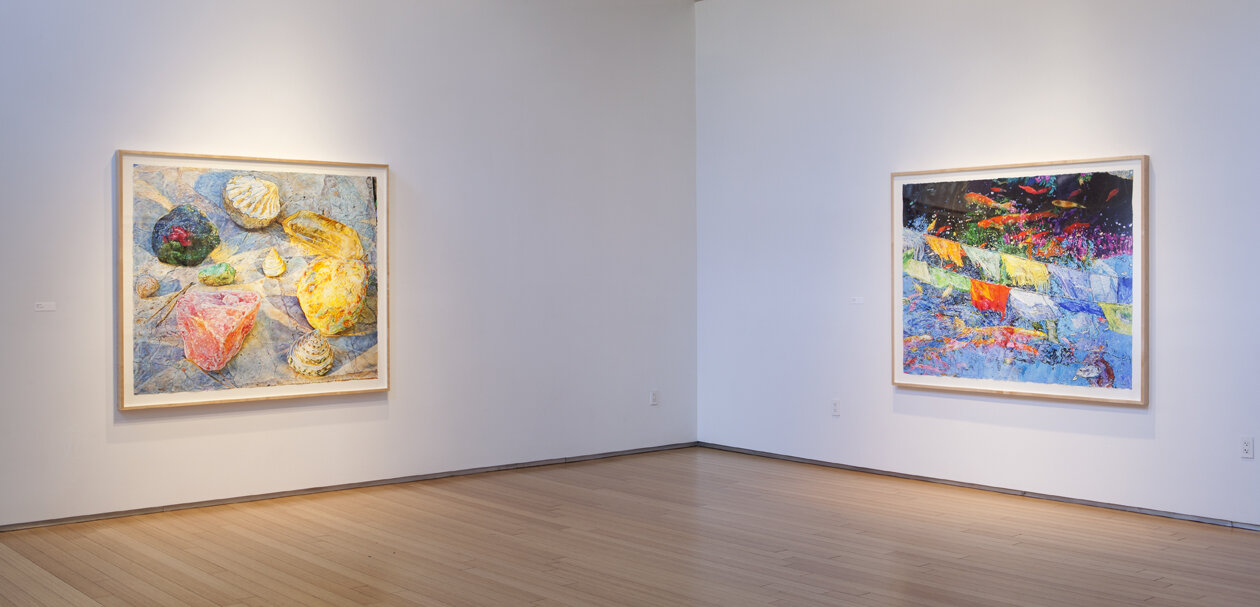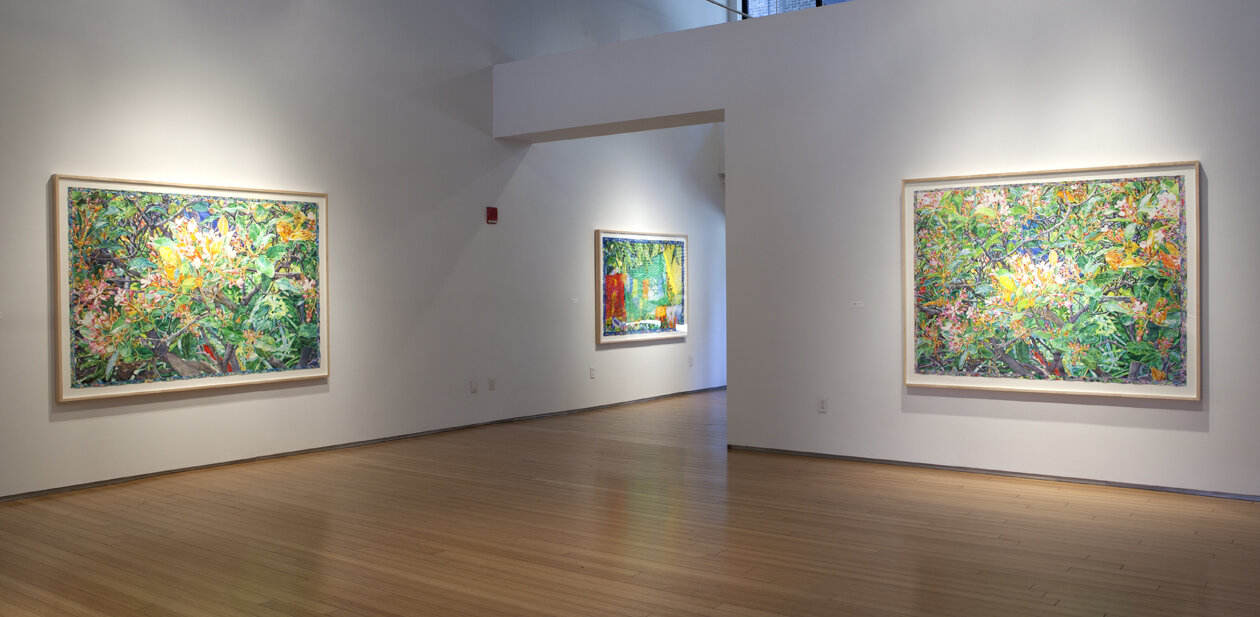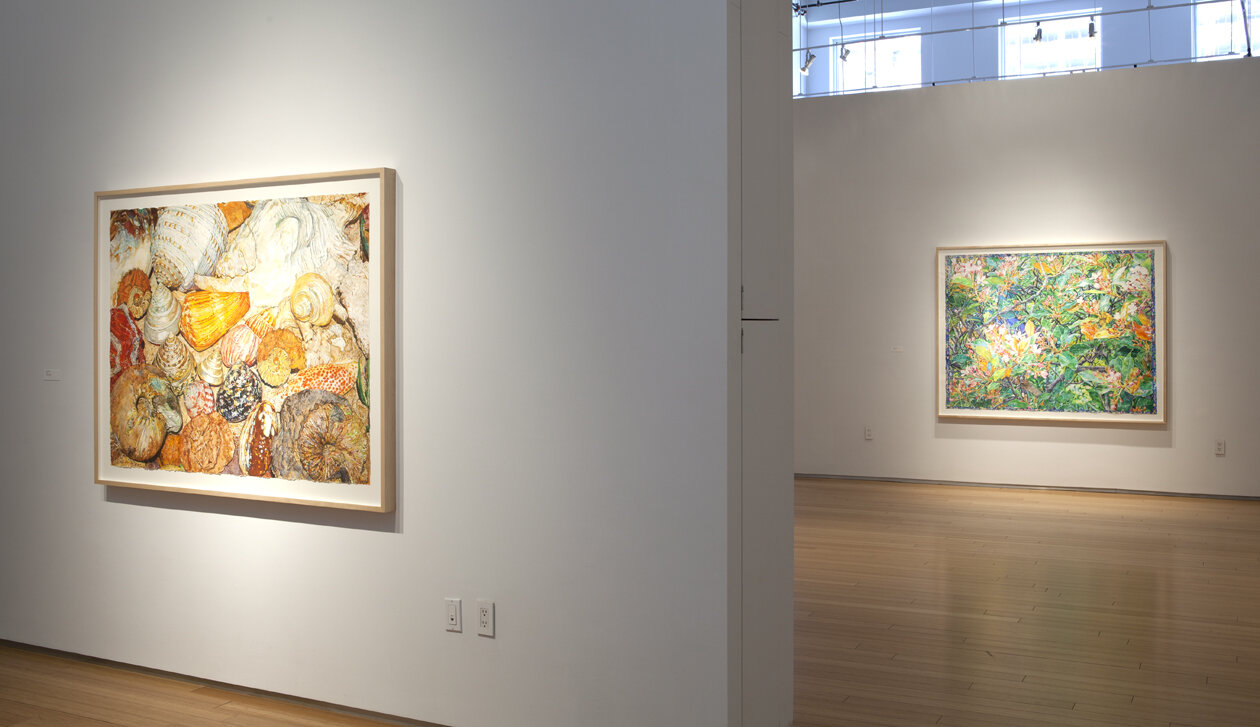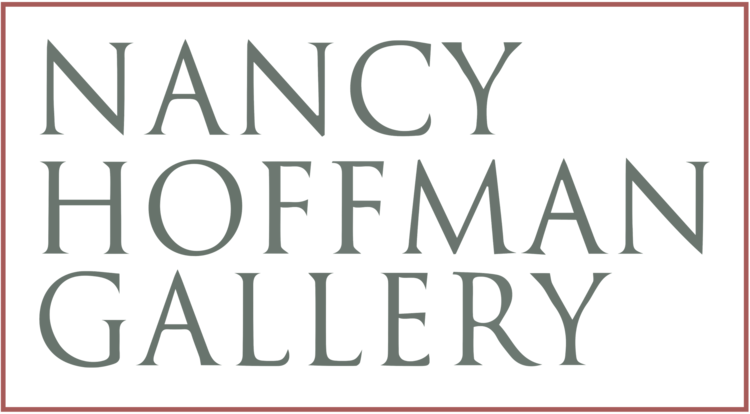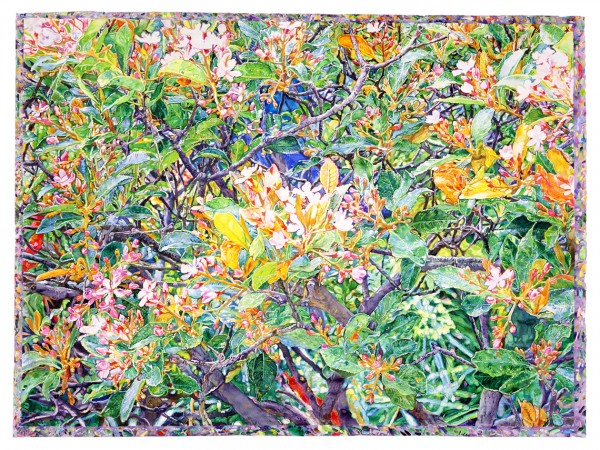Joseph Raffael: JR@EIGHTY
March 21 — May 4, 2013
On March 21st, an exhibition of monumental watercolors by Joseph Raffael, “JR@Eighty” opens at Nancy Hoffman Gallery, continuing through May 4th. The work in this show comprises three themes: gardens in refulgent bloom, shells and fossils, and the Japanese koi pond, in a word nature; the overriding theme that has engaged the artist not only for the past three years, but also for his entire practice of painting. The new work is more intimate, more intense, more filled with light and splendor. This is “Joseph Land,” the title of David Pagel’s essay for the catalogue accompanying the show, where the sun is always shining, and magic awaits.
Twenty-five years ago, Joseph Raffael and his wife Lannis moved to the South of France, wanting to simplify life so that Joseph could devote himself to painting without distraction. Over this quarter century, the couple, who live in a simple home overlooking the Mediterranean Sea, have created what might be called “Joseph Land.” Lannis planted a garden “sauvage,” in the midst of ancient trees and bushes and succulents, with flowers of every color of the rainbow. They created two koi ponds on the property, framed by stones the Mediterranean has washed smooth over millennia. The flowering plants matured, the carp grew large, the birds in the outdoor aviaries multiplied, and with the years, an earthly paradise blossomed. It is this paradise teeming with life force that provides the artist with his subjects: flowers, koi, birds, shells, the abundance of the gardens that surround their house.
New in this work is a sense of time, time passing, the urgency of the moment: a pond captured in a summer breeze, never to appear with the same shimmer or ripples again; a garden dense in foliage, with flowers peeking through a tapestry of myriad greens, a moment in springtime’s warmth. Selecting the “Moment” series with the garden subtitle “You Can’t Step Into the Same River Twice,” is an indication the artist has
time on his mind as he turns a new decade. These are not images of nature, these are abstractions inspired by nature, they are resplendent reflections on life, meditations on what it means to be alive. Each work is an ode to life in multi-color, “jewel-encrusted” passages of watercolor. These are watercolors to “fall into,” to roam about in and to explore. They are not quickly viewed or experienced. Every square inch is filled with rich color, interweaving squiggles, and lines and circles and facets, and juxtapositions that frolic and play with the mind and the eye, colors that cavort energetically across the paper, and cohabit joyfully. Simply stated Raffael’s new work is a celebration of life.
David Pagel writes of Raffael’s work:
“If you come to one of Raffael’s pictures of flowers or fish or water or seashells and crystals with an open mind, and believe that you have not seen it all, then it’s
likely that you will begin to see things you’ve never seen before, much less articulated, imagined, or grasped in the core of your being.
“That’s when the magic happens.
“And that’s the whole point of Raffael’s patiently painted pictures of readily identifiable flora and fauna. These intensely focused images, made up of innumerable dabs, strokes, and touches of a brush’s paint-saturated hairs, find freedom in discipline, or boundlessness in structure, and, in so doing, invite views to dive more deeply into the mysteries of ourselves, which, in the universe Raffael paints, have lots in common with the mysteriousness of others.”
Joseph Raffael was born in Brooklyn, New York in 1933. He attended Cooper Union, New York and received his B.F.A. from Yale School of Fine Arts. While at Yale he studied with Josef Albers. He also received a Fulbright Fellowship to Florence and Rome.
The artist’s work has been exhibited in this country at the American Academy of Arts and Letters, New York; ARCO Center for Visual Art, Los Angeles; Arkansas Art Center, Little Rock; The Art Institute of Chicago, Illinois; Art Museum of South Texas, Corpus Christi; Arts Center Galleries, Old Forge, New York; Arvada Art Center, Denver, Colorado; Bergstrom-Mahler Museum, Neenah, Wisconsin; The Butler Institute of American Art, Youngstown, Ohio; The Canton Museum of Art, Ohio; City University of New York, Baruch College; Columbus Museum of Art, Ohio; Davenport Museum of Art, Iowa; Delaware Art Museum, Wilmington; The Denver Art Museum, Colorado; Elvehjem Art Center, Madison, Wisconsin; Evansville Museum of Arts and Science, Indiana; Flint Institute of Arts, Michigan; Fort Collins Museum of Contemporary Art, Colorado; Fort Wayne Museum of Art, Indiana; Gibbs Museum of Art, Charleston, South Carolina, Charlotte and Philip Hanes Art Gallery, Wake Forest University, Winston-Salem, North Carolina Hunter Museum of Art, Chattanooga, Tennessee; The Jacksonville Museum, Florida; Las Vegas Museum of Art, Nevada; Minnesota Museum of Art, St. Paul; Museum of Art, Fort Lauderdale, Florida; Museum of Art, Midwestern State University, Wichita Falls, Texas Museum of Contemporary Religious Art, Saint Louis; Museum of Fine Arts, St. Petersburg, Florida; The Museum of Modern Art, New York; National Academy of Design, New York; Newport Art Museum, Rhode Island; Newport Harbor Art Museum, California; Oklahoma City Art Museum, Oklahoma; Parkland Art Gallery, Parkland College, Champaign, Illinois Pennsylvania Academy of the Fine Arts, Philadelphia; Polk Museum of Art, Lakeland, Florida; San Francisco International Airport, California; San Francisco Museum of Modern Art, California; Scottsdale Art Center, Arizona; Sioux City Art Center, Iowa; Smith College Museum of Art, Northampton, Massachusetts State University of New York, Soka University of America, Aliso Viejo, California; Stony Brook; Tucson Museum of Art, Arizona; Wichita Art Museum, Kansas; Whitney Museum of American Art, New York; Leigh Yawkey Woodson Art Museum, Wausau, Wisconsin; among other institutions. His work has also been shown at the Musee d’Art Moderne et Contemporain, Strasbourg, France; Fukui City Art Museum; Hokodate Museum of Art, Hokkaido; Iwaki City Museum; Iwate Prefectural Museum; Isetan Museum of Art, Tokyo; Kumamoto Prefectural Museum of Art; Miyagi Museum of Art, Sendai; Museum of Modern Art, Wakayama; Sogo Museum of Art; National Museum in Gdansk, Gdansk, Poland; Tochigi Prefectural Museum of Fine Arts; Tokushima Modern Art Museum; Museum of Modern Art, Shiba; and Kochi Prefectural Museum of Folk Art, all in Japan, and Kaohsiung Museum of Fine Arts, Taiwan.
Raffael’s work is represented in many museum collections, among them: Allentown Art Museum, Pennsylvania; The Art Institute of Chicago, Illinois; Boca Raton Museum of Art, Florida; Bauer Museum of Art, Valparaiso, Indiana; The Butler Institute of American Art, Youngstown, Ohio; The Canton Museum of Art, Ohio; The Cleveland Museum of Art, Ohio; The Contemporary Museum, Honolulu; Crocker Art Museum, Sacramento, California; Delaware Art Museum, Wilmington; The Denver Art Museum, Colorado; Des Moines Art Center, Iowa; Everson Museum of Art, Syracuse, New York; Fort Worth Art Museum, Texas; Hirshhorn Museum and Sculpture Garden, Smithsonian Institution, Washington, D.C.; Jacksonville Art Museum, Florida; Joslyn Art Museum, Omaha, Nebraska; Krannert Art Museum, Champaign, Illinois; Library of Congress, Washington, D.C.; Long Beach Museum, California; Los Angeles County Museum of Art, California; The Metropolitan Museum of Art, New York; Mint Museum, Charlotte, North Carolina; Museum of Contemporary Art, Chicago; Museum of Fine Arts, St. Petersburg, Florida; Museum of Outdoor Art, Englewood, Colorado; National Collection of Fine Arts of the Smithsonian Institution, Washington, D.C.; The Oakland Museum, California; Philadelphia Museum of Art, Pennsylvania; Rahr West Art Museum, Manitowoc, Wisconsin; San Francisco Museum of Modern Art, California; Santa Barbara Museum of Art, California; J.B. Speed Art Museum, Louisville, Kentucky; The Toledo Museum of Art, Ohio; Utah Museum of Fine Arts, Salt Lake City; Virginia Museum of Fine Arts, Richmond; Walker Art Center, Minneapolis; Washington County Museum of Fine Arts, Maryland; Whitney Museum of American Art, New York.
For information and/or photographs, please call the gallery at 212-966-6676 or email at info@nancyhoffmangallery.com
Yours sincerely,
Nancy Hoffman

